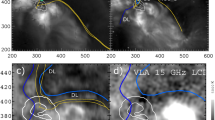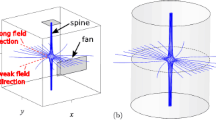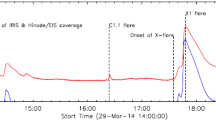Abstract
On May 1, 1993, a flaring X-ray bright point (XBP) was observed for about 16 hours in the old, disintegrating, bipolar active region (AR) NOAA 7493. During this period, a minor magnetic bipole (1020 Mx) emerged in the region. We have found observational evidence showing that the XBP brightenings were due to magnetic reconnection between the new bipole and pre-existing plage fields. The aim of the present work is to substantiate with magnetic modelling what has been shown by the observations. For this purpose we extrapolate the observed photospheric magnetic fields in the linear force-free approximation and follow its evolution during the lifetime of the XBP. From the computed coronal field lines we determine the location of regions of drastic change in field-line linkage, called ‘quasi-separatrix layers’ or QSLs. QSLs are open layers that behave physically like separatrices: the break down of ideal magnetohydrodynamics and the release of free magnetic energy may occur at these locations when their thickness is small enough. The extrapolated field lines, with photospheric footpoints on both sides of QSLs, match the observed chromospheric and coronal structures (arch filament system, XBP and faint X-ray loops (FXL)). We study also the evolution of the width of the QSL located over the new negative polarity pore: the calculated QSL is very thin (typically less than 100 m) during the lifetime of the XBP, but becomes much thicker (≥ 104 m) after the XBP has faded. Furthermore we show that peaks in X-ray brightness propagate along the FXL with a velocity of ≈ 670 km s-1, starting from the XBP location, implying that the energy is released where the emerging bipole impacts against pre-existing coronal loops. We discuss the possible mechanism of energy transport and conclude that the energy is conducted to the remote footpoints of the FXL by a thermal front. These results strongly support the supposition that the XBP brightness and flaring are due to the interaction of different flux systems, through 3D magnetic reconnection, at QSLs.
Similar content being viewed by others
References
Alissandrakis, C. E.: 1981, Astron. Astrophys. 100, 197.
Bagalá, L. G., Mandrini, C. H., Rovira, M. G., Démoulin, P., and Hénoux, J. C.: 1995, Solar Phys. 161, 103.
Bungey, T. N., Titov, V. S., and Priest, E. R.: 1996, Astron Astrophys. 308, 233.
Campbell, P. M.: 1984, Phys. Rev. 30, 365.
Démoulin, P., van Driel-Gesztelyi, L., Schmieder, B., Hénoux, J. C., Csepura, G., and Hagyard, M. J.: 1993, Astron. Astrophys. 271, 292.
Démoulin, P., Hénoux, J. C., and Mandrini, C. H.: 1994, Astron. Astrophys. 285, 1023.
Démoulin, P., Mandrini, C. H., Rovira, M. G., Hénoux, J. C., and Machado, M. E.: 1994, Solar Phys. 150, 221.
Démoulin, P., Hénoux, J. C., Priest, E. R., and Mandrini, C. H.: 1996a, Astron. Astrophys. 308, 643.
Démoulin, P., Bagalá, L. G., Mandrini, C. H., Hénoux, J. C., and Rovira, M. G.: 1996b, Astron. Astrophys., submitted.
Golub, L., Krieger, A. S., and Vaiana, G. S.: 1976, Solar Phys. 49, 79.
Golub, L., Harvey, J. W., and Webb, D. R.: 1986, in A. I. Poland (ed.), Coronal and Prominence Plasmas, NASA CP-2442, p. 365.
Golub, L., Krieger, A. S., Harvey, J. W., and Vaiana, G. S.: 1977, Solar Phys. 53, 111.
Golub, L., Krieger, A. S., Silk, J. K., Timothy, A. P., and Vaiana, G. S.: 1974, Astrophys J. 189, L93.
Gorbachev, V. S. and Somov, B. V.: 1988, Solar Phys. 117, 77.
Gorbachev, V. S. and Somov, B. V.: 1989, Soviet Astron. 33, 1, 57.
Harvey, K. L.: 1993, Ph.D. Thesis, University of Utrecht, The Netherlands.
Harvey, K. L., Nitta, N., Strong, K. T., and Tsuneta, S.: 1994, in Y. Uchida, T. Watanabe, K. Skibata, and H. S. Hudson (eds.), X-ray Solar Physics from Yohkoh, Frontiers Science Series, No. 10, p. 21.
Kundu, M. R., Strong, K. T., Pick, M., Harvey, K. L., Kane, S. R., White, S. M. and Hudson, H. S.: 1994, in S. Enome and T. Hirayama (eds.), Proc. of Kofu Symposium, NRO Report No. 360, p. 343.
Lau, Y. T.: 1993, Solar Phys. 148, 301.
Lau, Y. T. and Finn, J. M.: 1990, Astrophys. J. 350, 672.
Mandrini, C. H., Démoulin, P., Hénoux, J. C., and Machado, M. E.: 1991, Astron. Astrophys. 250, 541.
Mandrini, C. H., Rovira, M. G., Démoulin, P., Hénoux, J. C., Machado, M. E., and Wilkinson, L. K.: 1993, Astron. Astrophys. 272, 609.
Mandrini, C. H., Démoulin, P., Rovira, M. G., de la Beaujardière, J. F., and Hénoux, J. C.: 1995, Astron. Astrophys. 303, 927.
Martin, S. F., Livi, S. H. B., Wang, J., and Shi, Z.: 1985, in M. J. Hagyard (ed.), Measurements of Solar Vector Magnetic Fields, NASA CP-2374, p. 403.
Mickey, D. L.: 1985, Solar Phys. 97, 223.
Nolte, J. T., Solodyna, C. V., and Gerassimenko, M.: 1979, Solar Phys. 63, 113.
Parnell, C. E., Priest, E. R., and Golub, L.: 1994, Solar Phys. 151, 57.
Priest, E. R. and Démoulin, P.: 1995, J. Geophys. Res. 100, A12, 23443.
Priest, E. R. and Forbes, T. G.: 1992, J. Geophys. Res. 97, A2, 1521.
Priest, E. R. and Titov, V. S.: 1996, Phil. Trans. Roy. Soc. London 355, in press.
Rust, D. M., Simnett, G. M., and Smith, D. F.: 1985, Astrophys. J. 288, 401.
Schindler, K., Hesse, M., and Birn, J.: 1988, J. Geophys. Res. 93, 5547.
Staude, J., Hofmann, A., and Bachmann, G.: 1991, in L. November (ed.), Solar Polarimetry, Sunspot, New Mexico, p. 49.
Strong, K. T., Harvey, K. L., Hirayama, T., Nitta, N., Shimizu, T., and Tsuneta, S.: 1992, Publ. Astron. Soc. Japan 44, L161.
Tsuneta, S., Acton, L., Bruner, M., Lernen, J., Brown, W., Caravalho, R., Catura, R., Freeland, S., Jurcevich, B., Morrison, M., Ogawara, Y., Hirayama, T., and Owens, J.: 1991, Solar Phys. 136, 37.
van Driel-Gesztelyi, L., Hofmann, A., Démoulin, P., Schmieder, B., and Csepura, G.: 1994, Solar Phys. 149, 309.
van Driel-Gesztelyi, L., Schmieder, B., Cauzzi, G., Mein, N., Hofmann, A., Nitta, N., Kurokawa, H., Mein, P., and Staiger, J.: 1996, Solar Phys. 163, 145 (Paper I).
van Speybroek, L. P., Krieger, A. S., and Vaiana, G. S.: 1970, Nature 227, 818.
Webb, D. F., Martin, S. F., Moses, D., and Harvey, J. W.: 1993, Solar Phys. 144, 15.
Author information
Authors and Affiliations
Additional information
Member of the Carrera del Investigador Cientifíco, CONICET.
Also at Konkoly Observatory, Budapest, Pf. 67, H-1525 Hungary.
Rights and permissions
About this article
Cite this article
Mandrini, C.H., Démoulin, P., Van Driel-Gesztelyi, L. et al. 3D magnetic reconnection at an X-ray bright point. Sol Phys 168, 115–133 (1996). https://doi.org/10.1007/BF00145829
Received:
Revised:
Issue Date:
DOI: https://doi.org/10.1007/BF00145829




